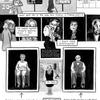5: Excerpt of a comic, Amy Kurzweil’s “Crossing Over,” 2018.
In her seven-page comic, “Crossing Over,” Kurzweil chronicles a visit to the Museum of Jewish Heritage in New York City in the wake of the publication of her memoir, Flying Couch. She describes encountering the Holocaust survivor avatars that are part of a museum exhibition—three-dimensional, full-bodied holograms who respond to direct questions and give their Holocaust testimony to visiting crowds.
Throughout the piece, Kurzweil grapples with what it means to have joined what she describes as “The Holocaust Economy”—the exhaustive exhibits, books, films, and artworks that depict experiences of the Holocaust, that can be consumed or bought. She wonders at the various, often conflicting impulses, including guilt, shame, curiosity, and love, that lead people to create representations of such experiences, as she did in her book, or to partake in them, as she does here with her visit to the museum (and as we do, when we read her memoir). She also grapples with what it means to hear Holocaust testimony from an avatar created via virtual reality rather than directly from an individual.
Suggested Activities: You can have students read the entire seven-page comic, or you can ask them to focus on just the page excepted here. Have the students consider the way the page is arranged in three tiers, with Kurzweil picturing herself in each. What is happening in each tier? What is happening between the tiers (what is not being depicted here)? Do they have any sense of what the narrator is thinking or feeling in each case? Be sure to also carefully discuss the various pieces of text throughout. What does the narrator mean by “Griefification”? Why does she include descriptions of the two avatars on the bottom, and why does she draw herself between them?
This discussion can easily lead to a larger conversation about different forms of Holocaust testimony, and different contexts for experiencing that testimony. Some examples might include firsthand listening (as in a personal interview), listening to a recording or reading a transcript, reading a graphic memoir, looking at photographs (in a museum, or in a photo album with a relative), or talking to a hologram. In what ways do the different mediums shape the experience of listening to someone’s story? Do certain mediums or settings feel more authentic than others? Why or why not? What might be some problems or concerns in learning about the Holocaust now that most survivors have died?
Challenge students to think through some of their assumptions, especially those that might come up regarding online technology as an inauthentic medium. Why might this feel true? Is virtual reality somehow further from reality than a video recording, or an audio one? Why or why not?
Source: Amy Kurzweil, “Crossing Over,” in The Believer, BelieverMag.com, August 1, 2018, https://believermag.com/crossing-over/.

